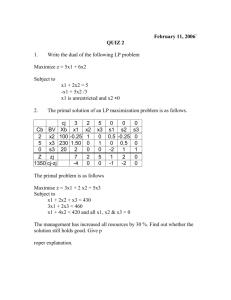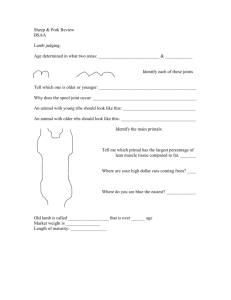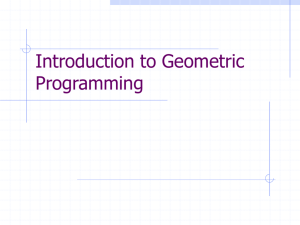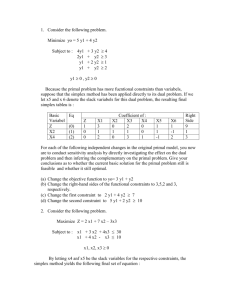Powerpoint - David Banach Saint Anselm College Course Server
advertisement
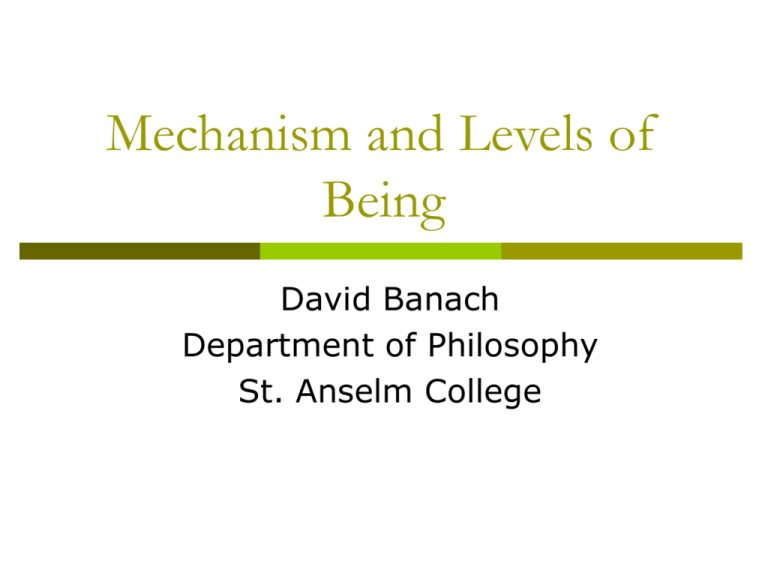
Mechanism and Levels of Being David Banach Department of Philosophy St. Anselm College A Great Irony Mechanism has made it difficult to take seriously the ideas of the Good or of metaphysical levels of being beyond the particular. Yet mechanism arose during the scientific revolution from a set of neo-platonic and neopythagorean attempts to resurrect the use of mathematical form to understand reality. In the Pythagoreans and Plato the idea of mathematical form was intimately tied to the idea that the reality and goodness of things in this world were jointly tied to their source in other levels of reality. Pythagoras and the joint discovery of the formal origin of both truth and beauty There is a hidden formal source of the order in our perceptual world This is also the source of the values we feel in things. Being Goodness form is the ultimate source of order and the ultimate object of desire The Scientific Revolution and Mechanism The scientific revolution was a set of technical innovations in purifying the appearances for study that allowed, for the first time, the methods of the Pythagoreans to be applied to the study of natural phenomena with great success. Galileo is able to say in The Assayer “Philosophy is written in this grand book, the Universe, which stands continually open to our gaze. . . . It is written in the language of mathematics, and its characters are triangles, circles, and other geometric figures without which it is humanely impossible to understand a single word of it.” Platonism turns on itself Plato and Pythagoras Reality is Number and Mathematical Form Mechanism Form as ultimate reality and ultimate good Form as ultimate reality and ultimate good Plato’s Timaeus (48e-56c ) 1. Way of Reason: A. Internal principle of Change. B. Orders things for the best. Works by persuasion, the presentation of attractive modes of being. 2. The Way of Necessity. Blind Matter constrained by its form. A. Must have a medium: the Receptacle B. Must have a external cause of its being and initial conditions: The Demiurge or nursemaid. C. Must have external rule that govern the relationships between its elements. D. Action is necessitated by the formal relations of the elements and their medium. Plato’s Primal Triangles Platonic Solids A Mechanical Theory of the Elements II. The Power of Mechanism: Lessons from the Game of Life 1. A clear Model of what Mechanism entails show that Mechanism cannot be true. 2. It also shows that the typical arguments for the necessity of form are inadequate. 3. It suggests a new way of arguing for form that a mechanist could (and would have to) accept. The Rules Of Life (1) An unoccupied cell surrounded by exactly three filled cells will become full or alive (2) A full or live cell surrounded by either two or three live cells remains alive (3) A live cell surrounded by more than three live cells dies, or becomes empty. More Life Resources dbanach.com/life 1-5 Pixel Patterns Random Pixels Stable Life Patterns Oscillating Patterns Gliders Acorn Breeder A Turing Machine in the Life World Self-Organization .5 .48 From Ron Knott, University of Surrey, http://www.mcs.surrey.ac.uk/Personal/R.Knott/Fibonacci/fibInArt.html Self-Organization .6 1.2 Self-Organization Various Ratios near .6 III The Limits of Mechanism A thoroughgoing Mechanism reveals its own limitations. Getting clear about the nature of mechanism reveals that reality can’t be mechanistic all the way down. It can’t be mechanical all the way down. 1. The pixels that constitute this world must have a medium, in this case the screen. 2. There must be a more fundamental reality which implements the program that governs the Life world, in this case the computer itself. 3. Finally, there must be some agency that is responsible for the actual operation of the program, in this case the factory that made the computer, the programmer who put it into the computer, and the user who pushes the button to run the program. The essence of mechanism is external compulsion by some substrate neutral rules or algorithms. Considering the Life World as a model shows that such a mechanism is not self-sufficient. Everything cannot be pixels; there has to be a screen on which the pixels exist and a computer to run the program. The Life World as Model of the Physical World Element of the Life world Element of Physical Reality it represents Pixels (Functional Representations in CPU) Fundamental Particles The Physical World Program Fundamental Laws of Nature Computer (and the rest of the world) Primal Reality that underlies our physical reality Large sustainable patterns of pixels Physical objects Meta-regularities or side effects of the Observable regularities of macroscopic program. objects. Screen/Keyboard/Agent Mind Input/Output module What can we know about Primal Reality? 1. Substrate neutrality seems to guarantee that we cannot now the nature of the Primal Reality. 2. There need not be unities or entities that correspond to those we find on the screen. A Virtual Pixel IV Reanimating Form Getting clear about how mechanism works reveals a new notion of how form works. What lies beyond the screen? The patterns in the Life world do not correspond to entities in the primal reality that gives rise to them, nor do the laws and regularities we can detect correspond to the laws that govern the program that gives rise to them. But 1. It is clear that their properties arise from formal aspects of the configuration of the pixels 2. We cannot know anything of the actual forms of causality that operate in the primal reality, or between it and our world. Two Levels of Being (1) A Formal Reality, however conceived, that describes the regularities and patterns that are instantiated in, but are not caused by, the rules of the program; and (2) An unintelligible Primal Reality that somehow gives rise to the implementation of the rules that generates this world. The Reality of Pattern The most salient features of the objects in the Life world arise from the formal constraints of the patters that its laws produce, not directly from those laws. Balls of Bats and the inverse square law Can we pose no hypotheses? Newton recognized the same relationship in deducing the inverse square law of gravitation, that mysterious force about which we are to pose no hypotheses. Even if we pose no hypotheses about what the source of gravity in the primal reality might be, we do know that something about it is spherical, or at least has the same formal constraints as the distribution of a uniform density onto the surface of a sphere. If in both cases if we assume that the distribution of bats, or whatever is causing/carrying gravity, is uniform, then the same number of bats will be distributed over a surface area that increases in proportion to the square of the distance, making the density on the surface of the sphere decrease in inverse proportion to the square of the distance. A new view of form 1. The forms we are capable of knowing are structural constraints on primal reality. They are patterns of being that constrain the very nature of the primal laws and pass down those constraints to the world they generate. 2. These constraints are implemented non-mechanically through the very structure of the medium and the way in which the program is implemented into it. What requires form? All physical objects composed of particles, like all patterns composed of multiple pixels, and all meta-regularities observable in these patterns, will require something like substantial form. The vast majority of the physical properties and laws that we can observe are not mechanical. What is an object? In the Grip of Form Energy Conservation Laws: The stable forms of matter that persist in our world are all equilibrium points or points of lowest energy for some physical system In mechanistic worlds whose laws have a certain type of symmetry or set of conservation stable patterns will arise who activities are governed more by the formal constraints of those patterns, than by the rules governing the particles. Objects are patterns of particles in the grip of a form. Form and Soul Physical Reality (Pixels and the three laws.) Fundamental particles and the laws that govern them. Primal Reality Soul Active principle Formal Reality Form (The Computer CPU and program) The physical system that Instantiates the Form in physical reality. Allows form to be relevant to physical reality. Pattern, the formal constraints imposed upon Being by form. Three things to notice Formal causation is not incompatible with mechanical causation or determination. Formal regularities are not mere epiphenomena or artifacts of our description: They constrain primal reality as well. Without infinite regress, these formal constraints cannot be implemented mechanically, by external compulsion. Form Persuades Necessity: The Good Returns If form cannot be externally imposed, one must describe it as arising from its attractiveness within the internal constitution of primal reality. Patterns are attractive modes of being in the primal reality that passes these patterns onto the physical reality it necessitates. Soul feels form and enforms objects with pattern. The Powers and Limits of Mechanism 1. Mechanism can explain the origin of, but not the nature of, most of the unities we find in experience. 2. A thoroughgoing Mechanism implies its own limits and reveals that the vast majority of the patterns we see, though they originate mechanically, are nonmechanical. Mechanism is your friend The proponent of form in the modern world should not oppose mechanism, but should insist upon it. If a thoroughgoing mechanism is true, it implies its own limits and requires the resurrection of a type of form that even a mechanist could love.
